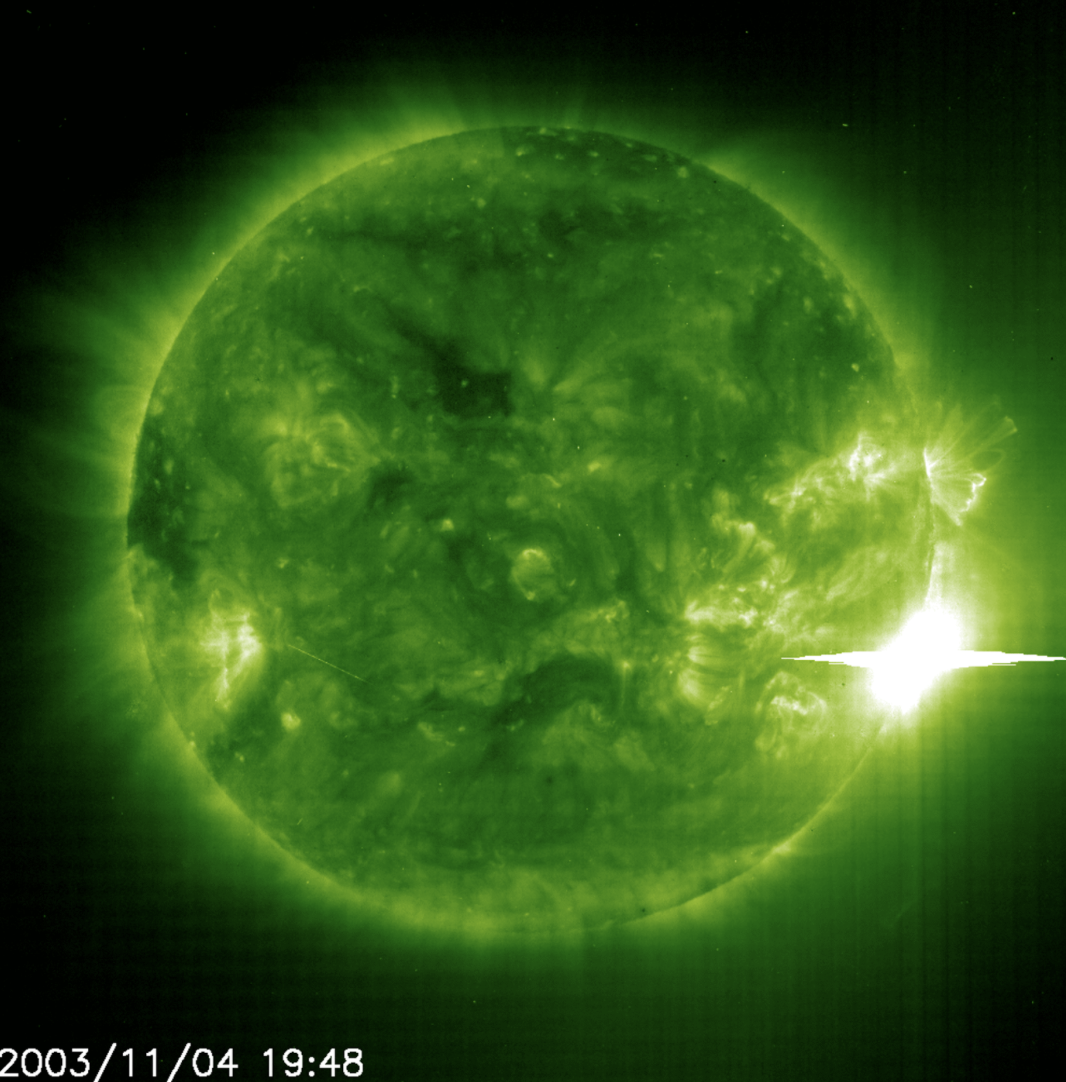By Victoria Hristova, Year 12,
Of course, I could not leave you hanging. I could not leave my fundamental question of why the Sun is so gassy unanswered. In part 1, I ended with the reasons for the sun’s cycle; the flip of polarities that takes place every 11 years or so. The whole cycle is then split into two specific instances: solar Minimum, and solar Maximum. The former corresponds to the moment after the change of polarities when sunspots are scarce and near the poles. Generally, it is of little interest, since the conditions for many phenomena are not yet present, and they do not happen with great intensity. Solar Maximum, on the other hand, is when all the magic happens.
Let us begin with an ever-present phenomenon known by the poetic name of solar wind. The Sun, as I’ve mentioned previously, is made up of plasma, plasma that, in the area of the corona (outermost layer of a star) is heated continuously to the point that the Sun’s gravity can’t hold it down as it expands. Remember that convoluted idea that the Sun has two components to its magnetic field, and they get tangled in each other with the star’s differential rotation? Near the poles, this creates an outward spiral of strong magnetism, which is dragged out even further by the constant stream of solar wind. As the winds of charged particles travel along those magnetic lines, they spread throughout the Solar System in a shape that resembles a ballerina’s twirling tutu. And so, these waves of particles travel, travel, travel some more, until they reach as far as three times the orbit of Pluto, stretched thin at these astronomical distances. Once the winds reach what is known as the heliopause (the place at which the pressure of the winds matches that of the interplanetary medium beyond), a bubble is formed around our Solar System, the heliosphere, one that protects everything within from the energetic rays of the Universe. But what do winds entail for us on Earth? Most of the time, not much. Truly the worst that can happen from solar winds would be a disruption in our electrical grids, but even that would require unimaginably strong streams, only really capable of happening during solar Maximum or in corotating interaction regions (essentially places where fast and slow winds superpose to create high energy and pressure areas).
The next solar phenomenon, climbing up the scale of extreme space weather, is solar flares. Those, to the difference of solar winds, are localized and temporary events. They consist of sharp eruptions or bursts of electromagnetic radiation, in all parts of the spectrum, as a consequence of the energy release associated with active regions, notably sunspots. Recent theories and observations prove that solar flares are initiated because of magnetic reconnection, a phenomenon in which magnetic fields connect and disconnect, the magnetic energy within is explosively converted to kinetic and thermal energy, resulting in surrounding particle acceleration. Regardless of whether this happens in an active region, or a solar arcade (magnetic fields forming loops above the surface), what it entails is a speeding up of particles around, and if a magnetic field “breaks away” from the closed loop, it carries all this buzzing matter with it, expunging it into space. Now, since we know that the number of sunspots and the complexity of their groups increase around solar Maximum, then it is fair to say that solar flares are also more common and stronger during this time as a consequence of the progressively more intricate magnetic lines. Often observed in x-rays or optical light, the flares are classified as A-, B-, C-, M-, or X-class, the last one so powerful it can cause radio blackouts on Earth, as the charged electrons in it bypass the outer layers of the atmosphere and decay or outright absorb certain frequencies of radio waves traveling at lower altitudes.
Last but not least, my favorite of all solar phenomena: coronal mass ejections (CMEs). CMEs and solar flares are misguidingly similar, their correlation to each other surprisingly obscure and unknown, with the greatest difference being that CMEs are carriers of huge amounts of heated plasma from the corona and embedded magnetic fields. Most of the time, they are a byproduct of a solar flare or any other kind of dynamic solar event, but on occasion, CMEs can happen on their own. In any case, since they transport dense and heated plasma, they can be much more impactful here on Earth.Like with solar flares, their strength waxes with solar Maximum, with up to 5 CMEs detected a day. Weaker ones pose no threat unless you consider shiny floating lights (aurorae) as threatening, but powerful events, such as the Carrington Event of 1859 (strongest ever recorded CME, during Maximum of solar cycle 10) are capable of damaging the electrical power grid as it did with the newly set up telegraph network in the USA. Rest assured, however, that in our modern times, it is possible to predict how long it will take for a CME to reach Earth (even the strongest ones take up to 15 hours) andmeasures can be taken, although commercial satellites could still be at risk.
By the wise words of an exasperated solar physicist I’ve been acquainted with, “your head will not hurt because of solar flares”. With that said, I aim to reassure you that the violent-sounding phenomena I’ve just described are not going to have any effect on your health, given that you stay put on Earth (if you are unfortunate enough to end up floating in emptyspace with no protective gear, you will not only perish by simultaneous boiling and freezing but also get severe radiation poisoning from solar events). Other than that, the Sun’s shenanigans will have no impact on you and your well-being.
And with that, my duology on the Sun’s gassiness is concluded—I sincerely hope I’ve not left you as tangled up as our star’s magnetic fields. As I was writing this article, the allusion of water being both vital and deadly came to me; in a much similar manner, the Sun is both mesmerizingly beautiful, a celestial mechanism whose buried wonders we have yet to find, and terrifyingly destructive, the outbursts of energy I’ve been meticulously describing equivalent to millions of tons of H-bombs. The marvels of our perfectly crafted Universe, I suppose.
If anyone is interested in watching CMEs as I sometimes do, here’s the link to NASA’s archive, dating back to 1996 🙂
Image credit: Giant solar flare in ultraviolet spectrum, by ESA/NASA



